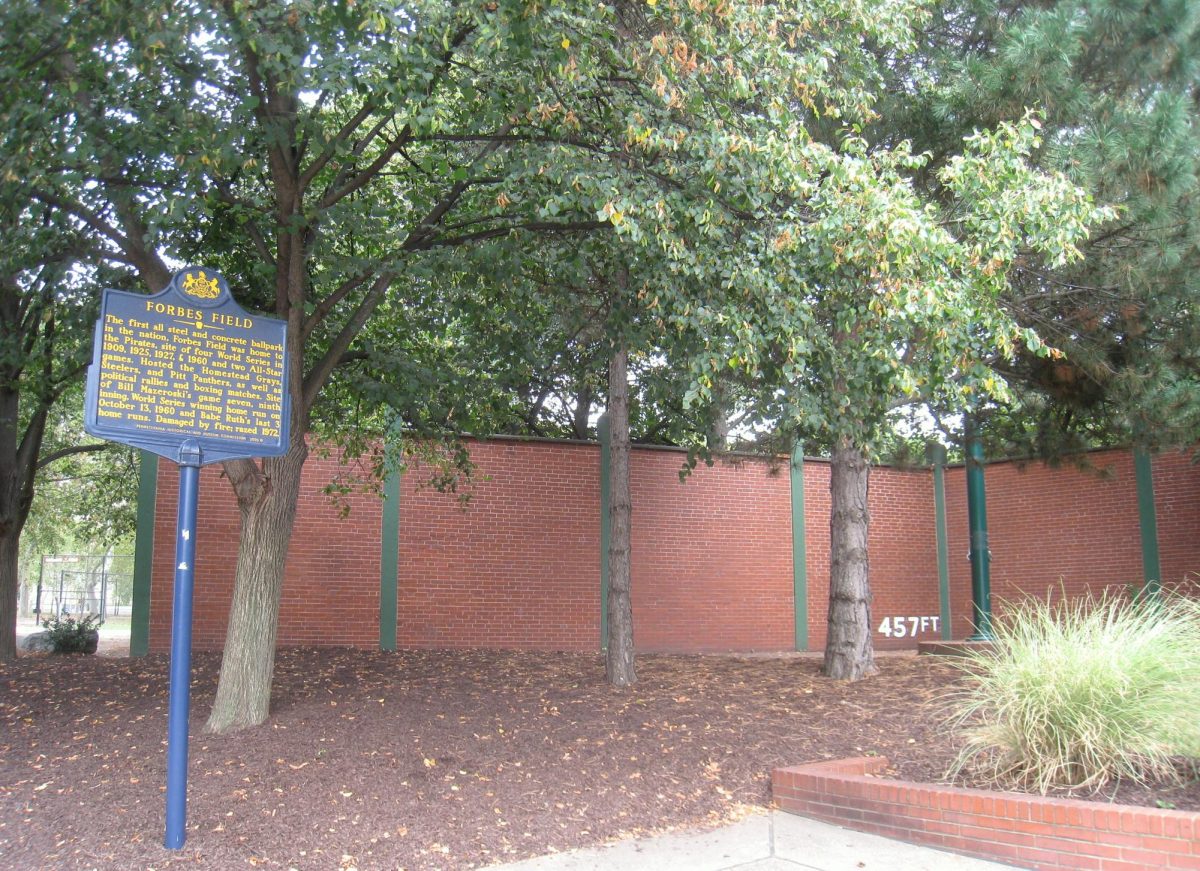As students walk around Pitt’s campus, most don’t realize the history they are standing on. The campus is home to some of the richest baseball history in the United States.
Though not much remains of the historic Forbes Field park, any Pitt student or visitor can find treasures of what once was. Today, the home plate used in the field’s final game rests in Posvar Hall, and the left-center and center field brick walls along with the flagpole, remain in their original locations.
To a disinterested onlooker, the wall and flagpole look out of place. But to faithful Pirates fans and baseball historians, they are of great significance.
Every year on October 13 — the anniversary of Bill Mazeroski’s famous walk-off home run to win the 1960 World Series — fans gather by the outfield wall and listen to a taped radio broadcast of the game. What started as one fan with a radio has now turned into an annual event with hundreds of participants, helping keep Forbes Field and its greatest memories alive.
In the very early 1900s, the Pittsburgh Pirates were in desperate need of a good home. The team had played in three different ballparks during their first nine years of existence, back when they were known as the Alleghenys. Starting in 1891 — the year they unofficially adopted the ‘Pirates’ name — the team called Exposition Park III home, but new owner Barney Dreyfuss wanted to build a more prosperous home for his team.
Needing more seating to accommodate the team’s heightened popularity and hoping to attract a more affluent audience to the games, Dreyfuss purchased seven acres near the Carnegie Library in 1903. Critics dubbed the land, which was underdeveloped at the time, “Dreyfuss’s Folly,” remarking his plans were too elaborate, too expensive and too far from Downtown — but Dreyfuss never wavered in his belief.
Ground broke in March of 1909, and the Nicola Building Company remarkably built the park in just 122 days at a cost of roughly $2 million. It was constructed of concrete and steel — solving the fire problem that plagued the team’s previous homes. Its location away from the river also rid the team of constant flooding concerns. Dreyfuss named the park Forbes Field after John Forbes, a general in the French and Indian War who helped build Fort Pitt in 1759.
Forbes Field was revolutionary for its features when it opened, including ramps and elevators to assist in fan movement, a clubhouse for visiting teams and public telephones on all floors — the first in a major league venue. The park was praised for the immense detail, described as “many years ahead of the so-called modern effects and innovations elsewhere.”
An estimated 35,000 fans — more than capacity — showed up on June 30, 1909 to christen the new ballpark, and nearly every famous face in town — from ex-players to Mayor William A. Magee — made an appearance. Dreyfuss was over the moon.
“This is indeed the happiest day of my life,” he told the Pittsburgh Press. “I used to dream of such things as I see here today, but it was not until a comparatively [short] time ago that I ever thought to see them as realities.”
Forbes Field would serve as the beacon for Pittsburgh sports for half a century. The Pirates won three World Series rings and seven NL pennants while playing there. The park was home to the last triple-header in major league history in 1920 and the first radio broadcast of a baseball game in 1921, among other historical accolades.
While the Pirates were its longest and most high-profile tenants, the venue also hosted the Pittsburgh Steelers, Pitt football and Homestead Grays during different times in its history.
Unfortunately, as the decades went on, Forbes Field had begun to show its age. Criticisms of the lack of development around the park proved wrong — the land actually developed too much, leading to a severe lack of parking and accessibility. The park had lost its charm by the time the University of Pittsburgh purchased it in 1958. Pitt had agreed to lease the stadium to the Pirates until they found a new place to play, a process that took more than a decade.
Nearly 41,000 fans packed into the park on June 28, 1970 for the team’s last day there. After the team left for Three Rivers Stadium, Pitt planned to demolish the now vacant park to expand their campus but faced fierce resistance from People’s Oakland, a group of citizens in the area dedicated to keeping it standing.
They compared Forbes Field to the Eiffel Tower in significance and proposed converting the ballpark into a mixed-use space, with classrooms, apartments, mom-and-pop stores and more.
Chancellor Wesley Posvar disagreed, but Pitt did agree to suspend their initial demolition plans to further consider People’s Oakland’s proposal. Two separate fires at the ballpark, however, eventually pushed Pitt to go forward with their plans to tear it down. Today, both Mervis and Posvar Hall sit on the land Forbes Field once occupied.


